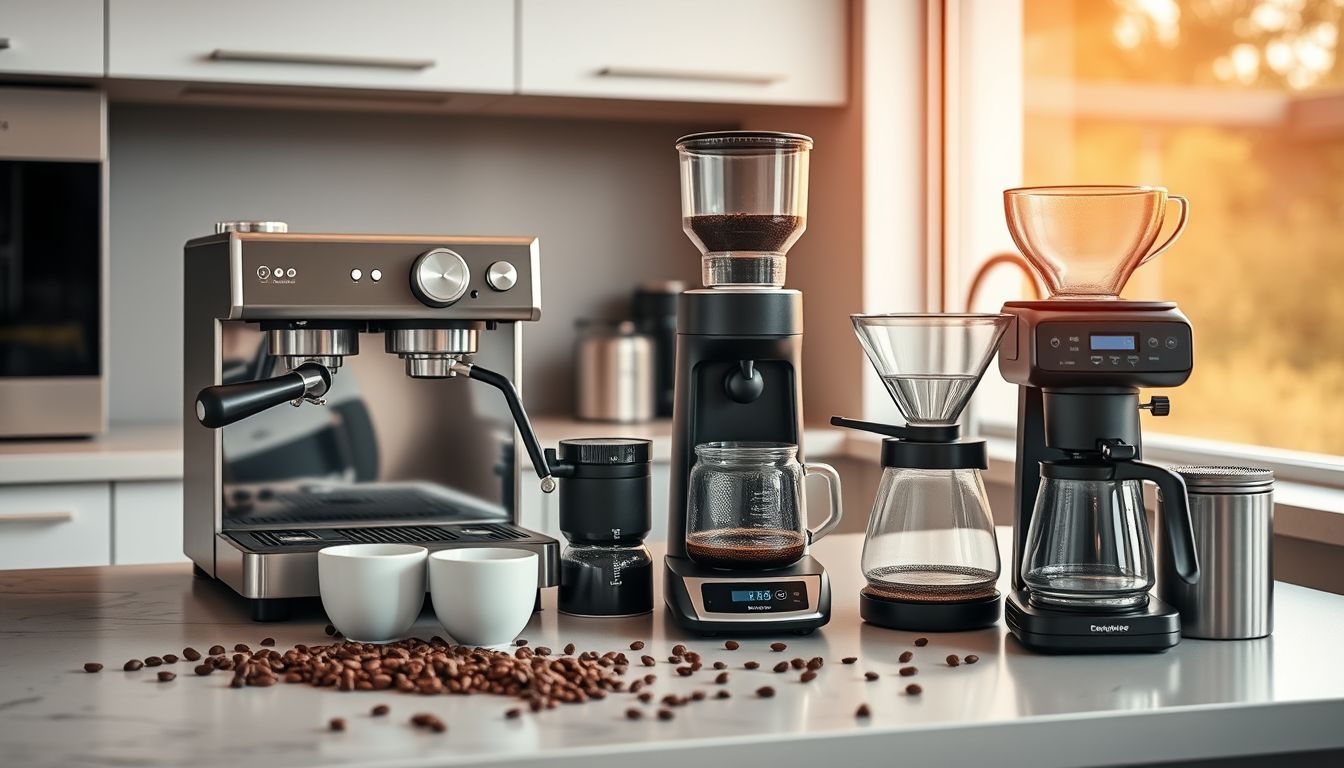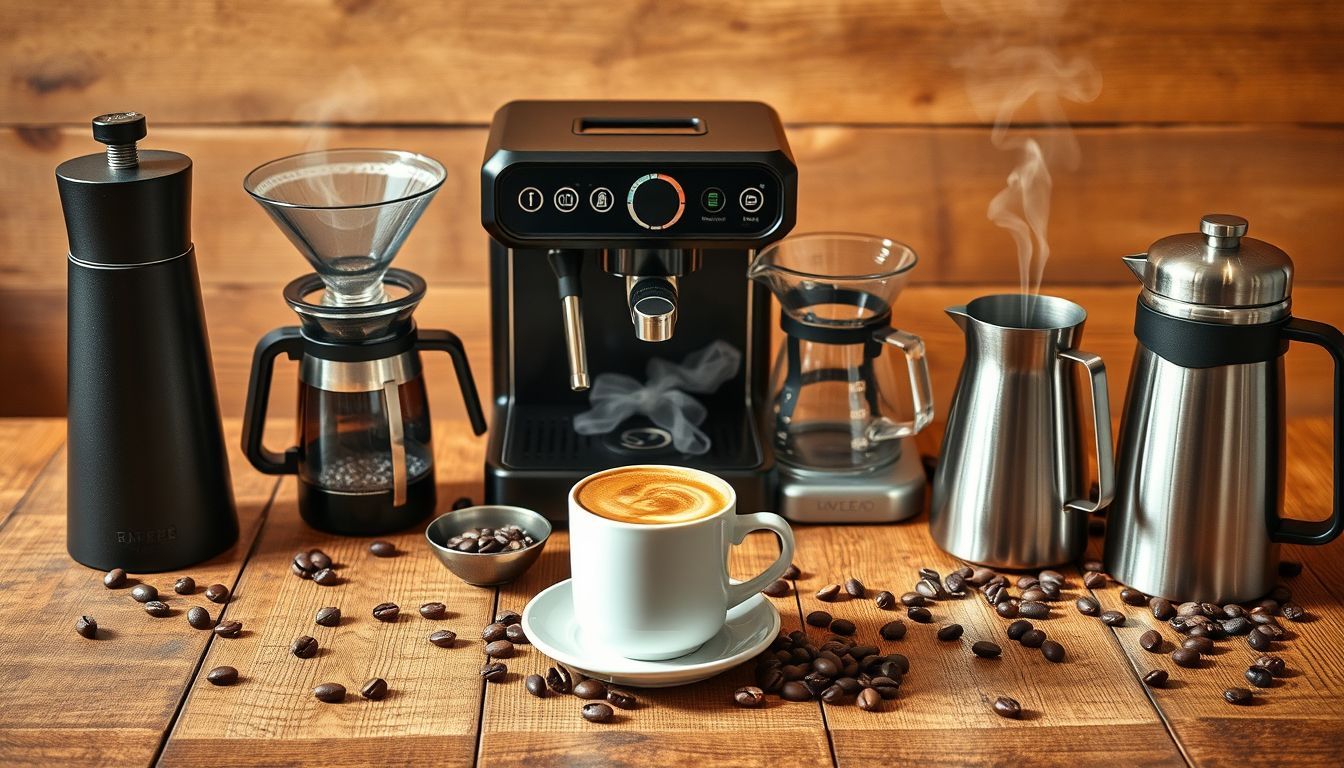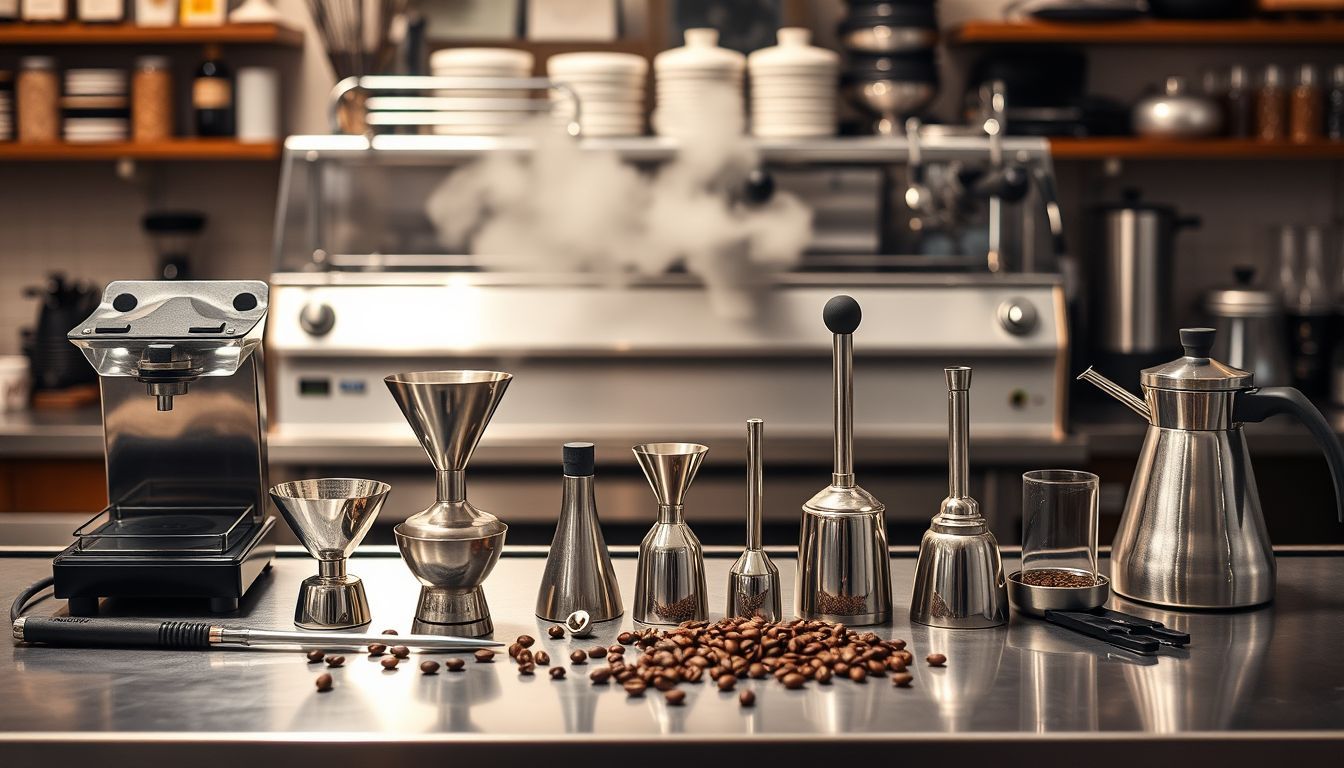The Ultimate Coffee Equipment Buyer's Guide for 2025
Navigate 2025's coffee equipment landscape with expert insights. From smart brewing tech to sustainable materials, discover what's worth buying and what's just hype.

Amazon Affiliate Disclosure
This post contains affiliate links. If you purchase through these links, we may earn a small commission at no additional cost to you.
The Ultimate Coffee Equipment Buyer’s Guide for 2025
As I write this, my kitchen counter resembles a coffee equipment graveyard—dozens of machines, grinders, and gadgets that promised to revolutionize my morning routine but now serve as expensive reminders of marketing’s triumph over practicality. There’s the $400 “smart” coffee maker that required a PhD in app navigation, the “revolutionary” grinder that produced revolutionary amounts of noise but conventional coffee, and the sleek espresso machine that looked stunning but pulled shots like a caffeinated disaster.
This collection of beautiful failures taught me something crucial about coffee equipment: the gap between what manufacturers promise and what actually improves your daily coffee has never been wider. In 2025, we’re drowning in options, from AI-powered brewing systems to subscription-based grinder services, but the fundamental question remains unchanged: what equipment actually makes better coffee versus what just makes better marketing?
After testing hundreds of pieces of equipment this year and watching the industry evolve through supply chain disruptions, sustainability mandates, and the post-pandemic home brewing boom, I’ve identified the trends that matter, the innovations worth your money, and the marketing myths you should ignore.
This isn’t just another equipment roundup—it’s your strategic guide to navigating 2025’s coffee landscape without falling into the same expensive traps that litter my counter.
The 2025 Coffee Equipment Landscape
Before diving into specific recommendations, let’s understand how the coffee equipment market has evolved and what forces are shaping purchasing decisions in 2025.
Major Industry Shifts
Sustainability Mandates
New regulations and consumer pressure have pushed manufacturers toward sustainable materials and repairable designs. The “right to repair” movement has finally reached coffee equipment, with companies now required to provide parts and service documentation for products sold in several markets.
Smart Integration Reality Check
After years of adding WiFi to everything, manufacturers are finally focusing on smart features that actually improve coffee rather than just collecting data. The novelty of app-controlled brewing has worn off, replaced by demand for genuinely useful automation.
Supply Chain Adaptations
Ongoing supply chain challenges have forced manufacturers to redesign products around available components, often resulting in simpler, more reliable designs. This constraint has paradoxically improved many products.
Home Brewing Maturation
The pandemic-driven home brewing boom has matured. Consumers now have experience with quality equipment and are making more informed second and third purchases rather than impulse buying.
What’s Actually New vs. What’s Marketing
Genuine Innovations:
- Improved burr materials and geometries
- Better temperature stability in budget machines
- Meaningful smart features (auto-dosing, extraction monitoring)
- Sustainable material adoption
- Modular, repairable designs
Marketing Rehashes:
- “Revolutionary” brewing methods that are minor variations
- Subscription-based equipment models
- Unnecessary app integration
- Premium pricing for cosmetic changes
- “Artisanal” mass-produced equipment
Category-by-Category Buying Guide
Grinders: The Foundation of Everything
Budget Champions ($100-$200)
Baratza Encore ESP ($169)
The 2025 refresh of the classic Encore adds espresso capability without sacrificing its legendary reliability. New burr geometry improves particle distribution, while the familiar repairable design ensures longevity.
Why it’s perfect for 2025: Addresses the biggest complaint about the original (espresso limitations) while maintaining everything that made it great.
Find it here: Baratza Encore ESP
Timemore C3 MAX ($89)
This manual grinder represents the maturation of hand-grinding technology. Improved ergonomics and burr design make it genuinely competitive with electric alternatives for most brewing methods.
Best for: Travelers, small kitchens, or anyone wanting excellent grinding without electrical complexity.
Mid-Range Marvels ($200-$500)
Fellow Opus ($195)
Fellow’s first grinder combines their design sensibility with serious grinding performance. The anti-static technology actually works, and the grind quality rivals machines costing twice as much.
Eureka Mignon Specialita 2025 ($449)
The updated Specialita addresses the original’s few weaknesses: improved retention, quieter operation, and better build quality. Still the espresso grinder benchmark in this price range.
Premium Performers ($500+)
Mahlkönig X54 Allround ($899)
The “Allround” variant adds filter brewing optimization to the excellent X54 platform. Interchangeable burr sets let you optimize for espresso or filter without buying multiple grinders.
Weber Key ($1,200)
Weber’s entry into home grinding brings commercial-grade uniformity and the most advanced anti-static system available. Expensive but transformative for serious enthusiasts.
Espresso Machines: Complexity vs. Capability
Entry-Level Excellence ($300-$600)
Breville Bambino Plus 2025 ($349)
The refreshed Bambino Plus adds PID temperature control and improved steam wand performance. Still the best entry point into real espresso.
Key improvement: Temperature stability that rivals machines costing twice as much.
Find it here: Breville Bambino Plus 2025
Gaggia Classic Pro Evo ($499)
Gaggia’s 2025 update addresses every complaint about the Classic Pro: better temperature stability, improved steam wand, and enhanced build quality. The modding community’s favorite just got better.
Mid-Range Mastery ($600-$1,500)
Rancilio Silvia Pro X 2025 ($1,399)
The Pro X evolution adds smartphone connectivity that’s actually useful—remote preheating, maintenance reminders, and extraction logging that helps improve technique.
Lelit Elizabeth V3 ($1,299)
Lelit’s dual boiler masterpiece gets refined temperature control and improved reliability. Offers prosumer performance at enthusiast pricing.
Premium Powerhouses ($1,500+)
Decent DE1+ 2025 ($3,799)
The latest Decent iteration adds improved reliability and simplified operation while maintaining its reputation for ultimate control and data logging.
La Marzocco Linea Micra 2025 ($4,500)
Commercial-grade performance in a home-friendly package. The 2025 model adds smart features and improved energy efficiency.
Drip Coffee Makers: Automation Perfected
Thermal Carafe Champions
Technivorm Moccamaster KBG 2025 ($389)
The Dutch master gets subtle improvements: better carafe design, improved temperature stability, and enhanced durability. Still the gold standard for automatic drip.
Why it endures: Proves that good design doesn’t need constant reinvention.
Find it here: Technivorm Moccamaster KBGV Select 10-Cup
OXO 9-Cup 2025 ($249)
OXO’s popular brewer adds smart features that actually matter: automatic descaling reminders, brew strength adjustment, and improved thermal carafe performance.
Specialty Brewing Systems
Ratio Eight 2025 ($695)
Ratio’s beautiful brewer gets improved temperature control and better extraction consistency. Form and function finally in perfect harmony.
Pour-Over Equipment: Tradition Meets Innovation
Classic Performers
Hario V60 Ceramic 02 (Still $25)
Some things don’t need improvement. The V60 remains the pour-over benchmark, now available in new sustainable ceramic formulations.
Find it here: Hario V60 Ceramic 02
Chemex Classic 8-Cup ($55)
The iconic design gets subtle material improvements while maintaining its timeless aesthetic and performance.
Find it here: Chemex Classic 8-Cup
Modern Innovations
Fellow Stagg X Dripper ($75)
Fellow’s take on pour-over adds unique flow control and improved heat retention. Different enough to justify its existence.
Scales and Accessories: Precision Tools
Essential Scales
Acaia Pearl 2025 ($179)
The Pearl gets improved battery life, faster response times, and better water resistance. Still the professional standard.
Timemore Black Mirror Basic 2 ($69)
Excellent performance at a fraction of the Acaia’s cost. The 2025 version adds improved accuracy and build quality.
Smart Accessories
Fellow Atmos Vacuum Canister 2025 ($49)
Improved vacuum mechanism and better seal design. Simple, effective coffee storage.
Find it here: Fellow Atmos Vacuum Canister
Weber Dosing Cup 2025 ($35)
The anti-static dosing cup that actually works. Small improvements, big impact on workflow.
2025 Buying Strategies
Budget Allocation Framework
The 50/30/20 Rule:
- 50% of budget: Grinder (most important for quality)
- 30% of budget: Primary brewing device
- 20% of budget: Accessories and extras
Example Budget Distributions:
$500 Total Budget:
- Grinder: $250 (Baratza Encore ESP)
- Brewer: $150 (Hario V60 + Kettle)
- Accessories: $100 (Scale, filters, storage)
$1,500 Total Budget:
- Grinder: $750 (Mahlkönig X54)
- Brewer: $450 (Breville Bambino Plus)
- Accessories: $300 (Scale, tamper, cups, etc.)
Sustainability Considerations
Repairability Scoring:
- Parts availability and cost
- Manufacturer repair support
- Community knowledge and modifications
- Expected lifespan vs. replacement cost
Material Sustainability:
- Recycled content in construction
- End-of-life recyclability
- Energy efficiency during use
- Packaging and shipping impact
Future-Proofing Your Purchase
Technology Integration:
- Choose smart features that solve real problems
- Avoid proprietary ecosystems that might disappear
- Prioritize open standards and compatibility
- Consider manual alternatives for critical functions
Upgrade Path Planning:
- Buy equipment that grows with your skills
- Choose modular systems when possible
- Consider used market value and demand
- Plan for component replacement and upgrades
What to Avoid in 2025
Subscription-Required Equipment
Your coffee maker shouldn’t have monthly fees.
Proprietary Pod Systems
Locked ecosystems that limit coffee choices and create ongoing costs. The environmental impact alone should be disqualifying.
Overly Complex Smart Features
If you need a manual to make coffee, the technology has failed. Smart features should simplify, not complicate.
Non-Repairable Designs
Equipment designed for disposal rather than repair. Look for companies that support long-term ownership.
Marketing Myths to Ignore
- “Revolutionary” brewing methods: focus on execution quality over novelty.
- “Professional-Grade” claims: look for actual specifications and performance data.
- “AI-Powered” everything: true AI in coffee equipment is rare and often unnecessary.
Regional and Availability Considerations
Supply Chain Realities
Popular Equipment Shortages: Have backup options and consider pre-ordering popular items.
Regional Price Variations: Factor in total cost including shipping and potential customs fees.
Service and Support: Consider local service availability, especially for complex equipment.
Import and Warranty Considerations
Gray Market Equipment: May lack warranty support.
Voltage and Plug Compatibility: Ensure electrical compatibility with your region.
Conclusion: Buying Smart in 2025
The coffee equipment landscape in 2025 offers more genuine innovation and value than we’ve seen in years. Manufacturers have finally learned to focus on performance over gimmicks, sustainability over disposability, and user experience over feature lists.
The key to successful equipment buying in 2025 is understanding your actual needs versus your aspirational wants. That $4,000 espresso machine might be impressive, but a well-chosen $400 setup often produces better daily coffee for most people.
Most importantly, remember that equipment is just the foundation. The best grinder in the world won’t save stale beans, and the most advanced espresso machine can’t compensate for poor technique. Invest in quality equipment that matches your skill level and commitment, then focus on the fundamentals that actually determine coffee quality.
The coffee equipment that will serve you best in 2025 is the gear you’ll actually use consistently, maintain properly, and enjoy operating. Sometimes that’s the latest high-tech marvel, sometimes it’s a simple manual setup that’s been perfected over decades.
Choose equipment that supports your coffee goals rather than impressing your guests. Your taste buds—and your bank account—will thank you for the pragmatic approach.
The future of coffee equipment is bright, sustainable, and focused on what actually matters: helping you brew better coffee, one cup at a time. Make your choices accordingly, and 2025 will be your best coffee year yet.
What coffee equipment are you considering for 2025? Have you noticed the industry trends I’ve highlighted, or are there other factors driving your purchasing decisions? I’m always curious about what influences equipment choices in the real world versus what manufacturers think matters.

Sofia Rossi
I started my career in a world of spreadsheets and boardrooms, but I quickly realized the most interesting data was in the way people interacted when the pressure was on. My novels are my way of analyzing the human heart—the messy, complicated, and often hilarious parts. I write about the lives we lead now, with all the love, ambition, and absurdity that comes with it.


